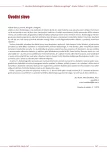Angiopathy and the eye
Authors:
E. Rencová
Authors‘ workplace:
Oční klinika Lékařské fakulty UK a FN Hradec Králové, přednosta prof. MU Dr. Pavel Rozsíval, CSc., FEBO
Published in:
Vnitř Lék 2010; 56(4): 333-339
Category:
11th National Diabetes Symposium "Diabetes and Angiology", Hradec Kralove, 5 to 6 June 2009
Overview
Introduction:
Diabetic retinopathy is an important microvascular complication of diabetes as it threatens the vision. Diabetic maculopathy is the main cause of legal blindness in the adult population in western countries.
Methods:
The examination method involves digital fundus photography that enables comparison of the incidence, number as well as the size and the shape of pathological foci on the retina during patient visits. It, however, does not depict one important change – chronic retinal ischemia. This is identified using contrast imaging – fluorescein angiography (FAG). Administration of a contrast medium – fluorescein – into cubital vein enables depiction of non‑perfused regions of the retina that form the basis for laser therapy indication as part of the prevention of proliferative diabetic retinopathy. Optical coherence tomography (OCT), during which an optical beam makes a cross ‑ section through all 10 layers of the retina, is an important advance in the diagnostics of diabetic macular oedema. The spectral OCT (S ‑ OCT) in particular is an analogy of a histological examination of retina but on a living tissue.
Results:
Owing to the advances in examination techniques and treatment methods, diabetic neuropathy can now be diagnosed and treated. Early diagnosis of vascular and, consequently, tissue changes in the retina, and in its midsection in particular, is a prerequisite. Tight control of diabetes and the risk factors is sufficient to maintain good visual acuity in patients with intact inner blood ‑ retinal barrier. In collaboration with a diabetologist, fenofibrates are used as the first line treatment when the inner blood ‑ retinal barrier is disturbed (damaged tight junctions between endothelial cells of retinal vessels). To reduce focal macular oedema, the sources of fluid leakage into central retina are occluded using laser interventions on microaneurysms. In diffuse macular oedema, a more intensive laser technique using grid laser coagulation is applied to the central region as well as the surrounding areas of non‑perfused retina. It is our view that major macular oedemas often result from an occlusion of a branch of retinal or macular venule. This is why we recommend complementing, in collaboration with a diabetologist, laser treatment of macular oedema with trombolytics. The aim of diabetic macular oedema treatment is its early elimination to avoid irreversible damage to the outer segments and later to photoreceptor cells. These changes are the main cause of the previously mentioned legal blindness in diabetic patients and are well identifiable on S ‑ OCT.
Discussion:
Laser therapy is the gold standard in the treatment of diabetic macular oedema as well as diabetic retinopathy. However, efficacy is lacking if diabetes and the risk factors are not tightly controlled. Instead of laser therapy to treat diabetic macular oedema with or without macular traction, some authors use a more expensive and more complicated surgery technique (pars plana vitrectomy with internal limiting membrane peeling) performed at early stages of the disease.
Conclusion:
Prevention of microangiopathy of retinal vessels through tight compensation of diabetes and the risk factors form the basis of successful treatment of diabetic retinopathy and maculopathy. At present, we are able to successfully treat developed diabetic retinopathy as well as maculaopathy, including stabilisation of visual function, subject to early diagnosis of retinal changes.
Key words:
diabetic retinopathy – diabetic macular oedema – fluorescein angiography – optical coherence tomography – laser coagulation
Sources
1. Orlidge A, D’Amore PA. Inhibition of capillary endothelial cell growth by pericytes and smooth muscle cells. J Cell Biol 1987; 105 : 1455 – 1462.
2. Adamis AP. Is diabetic retinopathy an inflammatory disease? Br J Ophthalmol 2002; 86 : 363 – 365.
3. Joussen AM. Is inflammation really so important in the pathogenesis of diabetic retinopathy? 9th EURETINA Congress 14. – 17. May 2009, Nice, France.
4. Retmarker – Automatic detection of retinal changes. Available from www.critical ‑ health.com.
5. Fiala JC. Reconstruct: a free editor for serial section microscopy. J Microsc 2005; 218 : 52 – 61.
6. Early photocoagulation for diabetic retinopathy. ETDRS report number 9. Early Treatment Diabetic Retinopathy Study Research Group. Ophthalmology 1991; 98 (Suppl 5): 766 – 785.
7. Maia OO Jr, Takahashi BS, Costa RA et al. Combined laser and intravitreal triamcinolone for proliferative diabetic retinopathy and macular edema: one‑year results of a randomized clinical trial. Am J Ophthalmol 2009; 147 : 291 – 297.
8. Cunha ‑ Vaz JG, Fonseca JR, Abreu JR et al. Studies on retinal blood flow II. Diabetic retinopathy. Arch Ophthalmol 1978; 96 : 809 – 811.
9. Anonymous. Photocoagulation for diabetic macular edema. Early Treatment Diabetic Retinopathy Study report number 1. Early Treatment Diabetic Retinopathy Study research group. Arch Ophthalmol 1985; 103 : 1796 – 1806.
10. Češka R. Ovlivnění diabetické retinopatie účinky fenofibrátu – studie FIELD. Farmakoterapie 2008; 3 : 271 – 272.
11. Fišer I. Peeling membrana limitans interna v cirurgické léčbě diabetického makulárního edému. Dizertační práce 2008.
12. Classification of diabetic retinopathy from fluorescein angiograms. ETDRS report number 11. Early Treatment Diabetic Retinopathy Study Research Group. Ophthalmology 1991; 98 (Suppl 5): 807 – 822.
13. Barakat MR, Schachat P. Current management of diabetic macular edema. Saudi J Ophthalmol 2009; 23 : 31 – 36.
14. Cunha ‑ Vaz J. Anti‑VEGF local treatment in high risk patients. 9th EURETINA Congress 14. – 17. May 2009, Nice, France.
Labels
Diabetology Endocrinology Internal medicineArticle was published in
Internal Medicine

2010 Issue 4
Most read in this issue
- Angiopathy and the eye
- Peripheral arterial disease and diabetes
- Surgical treatment of ischemic heart disease and diabetes mellitus
- Diabetes mellitus and ischemic heart disease
